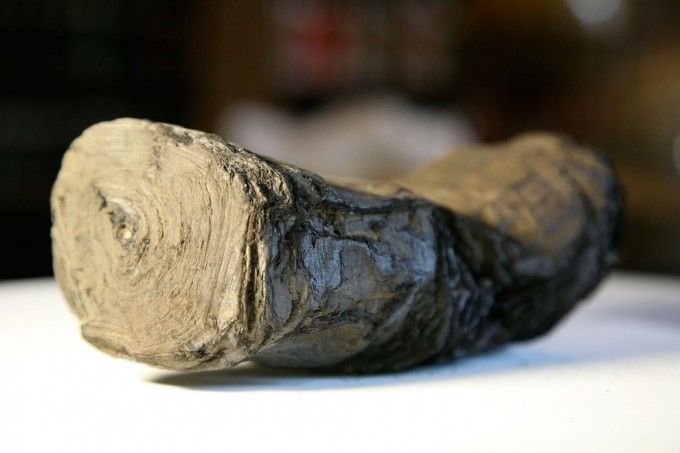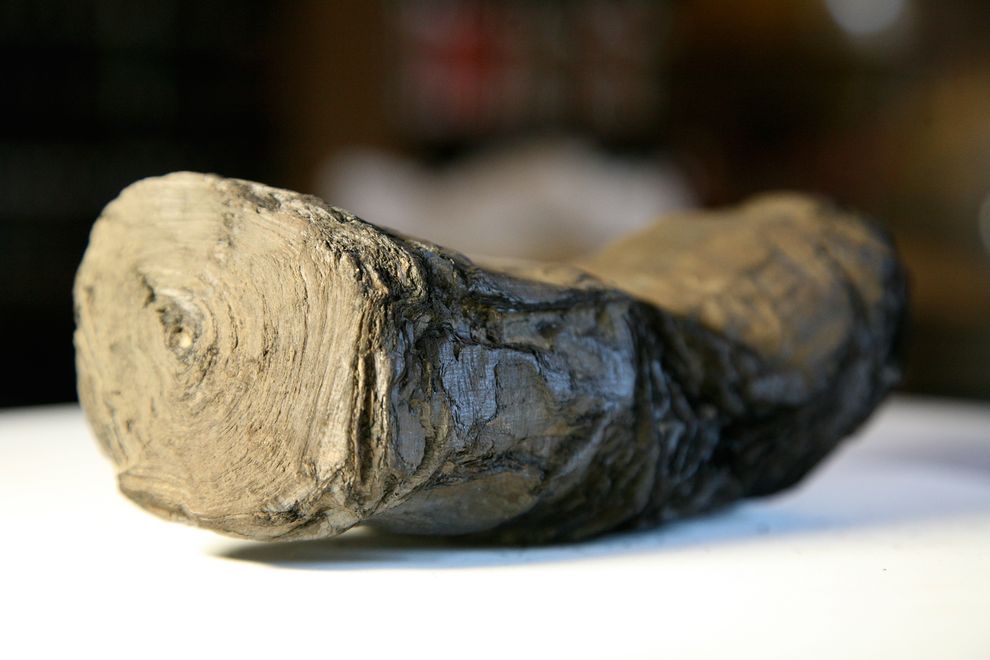Hundreds of papyrus scrolls that were found in the Roman town of Herculaneum, long believed to be too damaged to be ever read again, are now being deciphered thanks to a new non-invasive X-ray imaging technique.

The European researchers have able to reveal Greek letters hidden deep inside a charred scroll. Their findings also enabled them to formulate a hypothesis about the identity of the text’s author. This interdisciplinary work, published earlier this month in Nature Communications, raises hopes that it may eventually be possible to decipher all the papyri in the ancient library of Herculaneum.
During the eruption of Vesuvius in 79 AD that destroyed Pompeii, hundreds of papyrus scrolls were buried under several layers of volcanic material. An entire library was uncovered 260 years ago in Herculaneum. Some of the library’s papyri were preserved and have survived to the present day. They form a unique cultural treasure since there are probably no other copies of the texts they contain.
These carbonized scrolls are extremely fragile. Any attempt to open them and read the contents could break them up or even destroy them. Over the past few decades, various imaging techniques have been used to try to read the papyri without unrolling them, but so far to no avail. In this article, the researchers present a new method that has enabled them to decipher several letters and words inside a scroll without damaging it.
The ink used in antiquity was made from carbon obtained from smoke residues. Its density is therefore almost identical to that of a carbonized sheet of papyrus, which makes it difficult to distinguish using conventional X-ray methods. The X-ray phase-contrast tomography (XPCT) technique used in this work makes it possible to better distinguish the ink from the paper by using the difference in refractive index. This technique also relies on the fact that the ink does not penetrate into the plant fibers, so that the letters stand out in very slight relief from the paper’s surface. This difference of a few hundred microns makes it possible to amplify the contrast between the two components of the scroll and reveal the letters.

By using XPCT to study two Herculaneum papyri from the Institut de France’s collection, the researchers were able to read words buried under several layers of paper or on deformed whorls of the roll that had adhered to one another. They also successfully reconstructed a nearly complete Greek alphabet from a papyrus that is still rolled up. By analyzing the writing style and comparing it with a previously studied text, they were able to put forward hypotheses about the age of the carbonized scroll and about its author: the roll may contain a text by the Epicurean philosopher Philodemus writing in his school during the first century BC.
This technical breakthrough, which makes it possible to detect traces of ink within a carbonized papyrus roll without compromising its integrity, has long been awaited. By developing it further, researchers should be able to obtain the image of an entire papyrus scroll in just a few hours under a synchrotron beamline – and eventually decipher all the philosophical texts contained in the scrolls in Herculaneum’s ‘Villa of the Papyri’.
Vito Mocella, one of the researchers involved int the study, said “It’s always hard to make a precise prediction, but with resources, the scrolls should be readable within the next decade.”
Sponsored Content


Hundreds of papyrus scrolls that were found in the Roman town of Herculaneum, long believed to be too damaged to be ever read again, are now being deciphered thanks to a new non-invasive X-ray imaging technique.
The European researchers have able to reveal Greek letters hidden deep inside a charred scroll. Their findings also enabled them to formulate a hypothesis about the identity of the text’s author. This interdisciplinary work, published earlier this month in Nature Communications, raises hopes that it may eventually be possible to decipher all the papyri in the ancient library of Herculaneum.
During the eruption of Vesuvius in 79 AD that destroyed Pompeii, hundreds of papyrus scrolls were buried under several layers of volcanic material. An entire library was uncovered 260 years ago in Herculaneum. Some of the library’s papyri were preserved and have survived to the present day. They form a unique cultural treasure since there are probably no other copies of the texts they contain.
These carbonized scrolls are extremely fragile. Any attempt to open them and read the contents could break them up or even destroy them. Over the past few decades, various imaging techniques have been used to try to read the papyri without unrolling them, but so far to no avail. In this article, the researchers present a new method that has enabled them to decipher several letters and words inside a scroll without damaging it.
The ink used in antiquity was made from carbon obtained from smoke residues. Its density is therefore almost identical to that of a carbonized sheet of papyrus, which makes it difficult to distinguish using conventional X-ray methods. The X-ray phase-contrast tomography (XPCT) technique used in this work makes it possible to better distinguish the ink from the paper by using the difference in refractive index. This technique also relies on the fact that the ink does not penetrate into the plant fibers, so that the letters stand out in very slight relief from the paper’s surface. This difference of a few hundred microns makes it possible to amplify the contrast between the two components of the scroll and reveal the letters.
By using XPCT to study two Herculaneum papyri from the Institut de France’s collection, the researchers were able to read words buried under several layers of paper or on deformed whorls of the roll that had adhered to one another. They also successfully reconstructed a nearly complete Greek alphabet from a papyrus that is still rolled up. By analyzing the writing style and comparing it with a previously studied text, they were able to put forward hypotheses about the age of the carbonized scroll and about its author: the roll may contain a text by the Epicurean philosopher Philodemus writing in his school during the first century BC.
This technical breakthrough, which makes it possible to detect traces of ink within a carbonized papyrus roll without compromising its integrity, has long been awaited. By developing it further, researchers should be able to obtain the image of an entire papyrus scroll in just a few hours under a synchrotron beamline – and eventually decipher all the philosophical texts contained in the scrolls in Herculaneum’s ‘Villa of the Papyri’.
Vito Mocella, one of the researchers involved int the study, said “It’s always hard to make a precise prediction, but with resources, the scrolls should be readable within the next decade.”
Sponsored Content